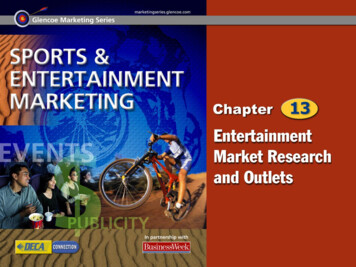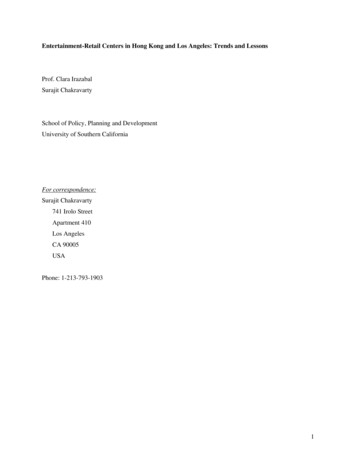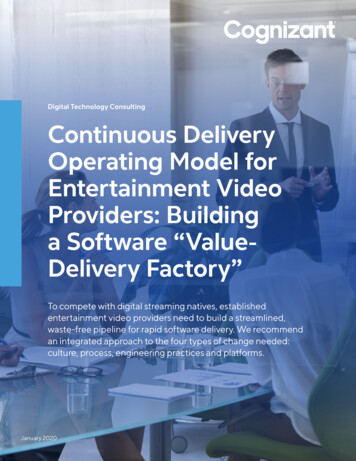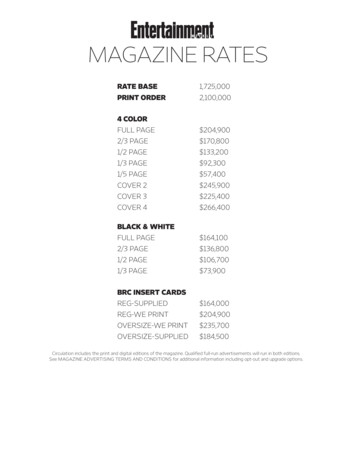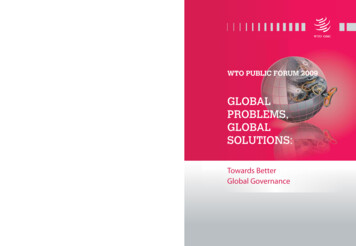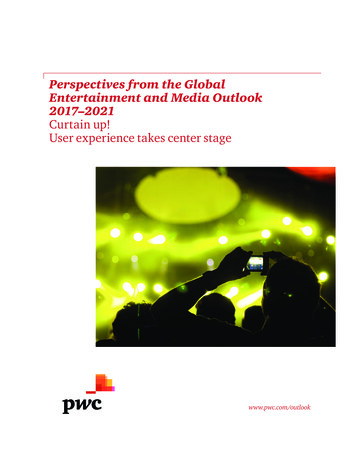
Transcription
Perspectives from the GlobalEntertainment and Media Outlook2017–2021Curtain up!User experience takes center stagewww.pwc.com/outlookPwcOutlook C1-21-fin3-050417.indd 15/5/17 10:54 AM
Use and permissionsThis document is provided by PwCfor general guidance only and doesnot constitute the provision of legaladvice, accounting services, investmentadvice, or professional consulting ofany kind. The information providedherein should not be used as a substitutefor consultation with professional tax,accounting, legal, or other competentadvisors. Before making any decisionor taking any action, you should consulta professional advisor who has beenprovided with all pertinent factsrelevant to your particular situation.The information is provided as is,with no assurance or guarantee ofcompleteness, accuracy, or timeliness ofthe information and without warrantyof any kind, express or implied,including but not limited to warrantiesof performance, merchantability, andfitness for a particular purpose. Contentfrom the articles in this publication mustnot be excerpted, used, or presentedin any portion that would render itmisleading in any manner or that failsto provide sufficient context.PwcOutlook C1-21-fin1-plusChanges.indd 2Permission to citeNo part of this publication may beexcerpted, reproduced, stored in aretrieval system, or distributed ortransmitted in any form or by anymeans — including electronic,mechanical, photocopying, recording,or scanning — without the priorwritten permission of PwC.Requests should be submitted in writingto Gary Rosen at gary.rosen@pwc.comoutlining the excerpts you wish to use,along with a draft copy of the full reportthat the excerpts will appear in. Provisionof this information is necessary for everycitation request to enable PwC to assessthe context in which the excerpts arebeing presented.Without limiting the foregoing, excerptsfrom the publication may be used onlyfor background market illustration,should not be the sole source of 2017–2021 information, and must not formthe majority of sourced information.About PwCPwC helps organizations and individualscreate the value they’re looking for.We’re a network of firms in 157 countrieswith more than 223,000 people whoare committed to delivering quality inassurance, tax and advisory services. Tellus what matters to you and find out moreby visiting us at www.pwc.comSupplier to the OutlookOvum, a provider of business intelligenceand strategic services to the globaltelecoms and media markets (which is atrading division of Informa Telecoms andMedia Ltd.)www.ovum.com 2017 PwC. All rights reserved. PwCrefers to the PwC network and/or oneor more of its member firms, each ofwhich is also a separate legal entity.Please see www.pwc.com/structurefor further details.Global entertainment and mediaoutlook is a trademark owned byPricewaterhouseCoopers LLP.Cover photograph: Jay Blakesburg / UpperCut Images / Getty ImagesPhotograph pages 8–9: Flashpop / Iconica / Getty ImagesUse of data in this publicationArticles in this publication are drawnfrom data in the Global entertainmentand media outlook 2017–2021, acomprehensive source of consumer andadvertising spend data available viasubscription at www.pwc.com/outlook.PwC continually seeks to update theonline Outlook data; therefore, pleasenote that the data in the articles inthis publication may not be alignedwith the data found online. The Globalentertainment and media outlook2017–2021 is the most up-to-datesource of consumer and advertisingspending data.5/2/17 12:00 PM
Perspectives from the GlobalEntertainment and Media Outlook2017–2021Curtain up!User experience takes center stagePwcOutlook C1-21-fin1.indd 15/1/17 2:51 PM
Global entertainment andmedia outlook country contactsGlobalDeborah Bothundeborah.k.bothun@pwc.comDenmarkLeif Ulbaek Jensenleif.ulbaek.jensen@dk.pwc.comJapanYoshihisa Chiyodayoshihisa.chiyoda@jp.pwc.comArgentinaAriel Vidanariel.vidan@ar.pwc.comEgyptJayant aAnthony Murageanthony.murage@pwc.comAustraliaMegan Brownlowmegan.brownlow@pwc.comFinlandHarri Valkonenharri.valkonen@fi.pwc.comKoreaBumtak Leebumtak.lee@kr.pwc.comAustriaHannes Orthoferhannes.orthofer@at.pwc.comFranceRichard Béjotrichard.bejot@fr.pwc.comMalaysiaIrvin Menezesirvin.menezes@my.pwc.comBelgiumKurt Cappoenkurt.cappoen@be.pwc.comGermanyWerner Ballhauswerner.ballhaus@de.pwc.comMexicoLuis Roberto la Vieiraestela.vieira@br.pwc.comGreecePanagiotis Zisispanagiotis.zisis@gr.pwc.comMiddle East/North AfricaJayant daJohn Simcoejohn.b.simcoe@pwc.comHungaryPeter Serepeter.sere@hu.pwc.comNetherlandsEnnèl van Eedenennel.van.eeden@nl.pwc.comChileAriel ank D’Souzafrank.dsouza@in.pwc.comNew ZealandKeren Blakeykeren.j.blakey@nz.pwc.comChina & Hong KongWilson Chowwilson.wy.chow@cn.pwc.comIndonesiaMohammad Chowdhurymohammad.chowdhury@id.pwc.comNigeriaOsere Alakhumeosere.alakhume@ng.pwc.comColombiaJorge Mario Añezjorge.anez@co.pwc.comIrelandAmy Ballamy.ball@ie.pwc.comNorwayEivind Nilseneivind.nilsen@pwc.comCzech RepublicTomas Bastatomas.basta@cz.pwc.comIsraelAmir Gleitamir.gleit@il.pwc.comPakistanSyed Shabbar Zaidis.m.shabbar.zaidi@pk.pwc.comItalyMaria Teresa rnardo Ducebernardo.duce@pe.pwc.com
PhilippinesMary Jade Roxasjade.roxas@ph.pwc.comThailandTina Hammondtina.ann.hammond@th.pwc.comPolandPawel Wesolowskipawel.wesolowski@pl.pwc.comTurkeyMurat Colakoglumurat.colakoglu@tr.pwc.comPortugalGoncalo Mendesgoncalo.saraiva.mendes@pt.pwc.comUAEJayant niaFlorin Deaconescuflorin.deaconescu@ro.pwc.comUnited KingdomPhil Stokesphil.stokes@pwc.comRussiaYury Pukhayury.pukha@ru.pwc.comUnited StatesDeborah Bothundeborah.k.bothun@pwc.comSaudi ArabiaJayant anie Kanestefanie.kane@pwc.comSingaporeCharlotte Hsucharlotte.hsu@sg.pwc.comSouth AfricaVicky Myburghvicky.myburgh@za.pwc.comSpainJorge Planes Trillojorge.planes.trillo@es.pwc.comChristopher Vollmerchristopher.vollmer@pwc.comVenezuelaManuel Pereyramanuel.pereyra@ve.pwc.comVietnamOng Tiong Hooitiong.hooi.ong@vn.pwc.comSwedenNicklas ick Balkanyipatrick.balkanyi@ch.pwc.comTaiwanDamian Gilhawleydamian.gilhawley@tw.pwc.comPwcOutlook C1-21-fin1.indd 35/1/17 2:51 PM
About this reportEach year we take a deep dive into thefindings of our Global entertainmentand media outlook. Whether you’re anewcomer to the Outlook or a longtimesubscriber to our data, you should regardthis document as an annual report forbusinesses that invest and operate inthe entertainment and media (E&M)industry and in related sectors, suchas technology, communications, retail,and e-commerce.Deborah BothunBrad SilverPwcOutlook C1-21-fin1.indd 4As you read through this report, we’reconfident you will come away withactionable business insights based onthe trends we’re identifying and chartingacross the 17 defined segments and54 countries our research covers. Theauthors of this report connect the dotsbetween the business challenges ourclients face today, whether they arecoping with value-chain disruption ormapping an M&A strategy, and the highlydetailed segment and country data thatemerges from the research.The intensive debate, discussion, andanalysis we engage in each year yieldsimportant insights. For 2017, we seean important set of takeaways thatshould inform and shape your strategy.Companies that wish to capture valueamid shifting consumer preferences andbusiness model disruptions must focuson an increasingly prominent source ofcompetitive advantage: user experience.They must harness technology and datato attract, retain, and engage users —and convert them into devoted fans.And these imperatives assume a largerimportance because, as we document,the E&M industry is confronting severalchallenges to continued top-line growth.To learn more about how the findings inthis report can apply to your business,or how your company can subscribe tothe full body of Outlook research, pleaseconnect directly with your local PwCteam. Alternatively, you can reach out toeither of us, and we’ll put you in touchwith our local leaders in your geography.We look forward to hearing from andworking with you.Best regards,Deborah BothunGlobal Entertainment & Media Leaderdeborah.k.bothun@pwc.comBrad SilverGlobal Technology, Media, andTelecommunications Leaderbrad.silver@pwc.com5/1/17 2:51 PM
Contents06 Methodology and definitions07 Contributors10 Curtain up!Outlook perspective22 Business modelsAs distribution splinters, adaptation is the name of the game26 Value chainsAcross E&M, companies chart a direct-to-consumer path29 Technological changeDriving incremental growth through innovation32 Content strategyAdapting to penetrate technological and cultural filters35 DealsStrong tailwinds38 RegulationMarket contrasts, net neutrality, and privacyIndexPwcOutlook C1-21-fin2-050417.indd 55/4/17 11:12 AM
Methodology and definitionsHistorical data collectionAll forecasts have been built startingwith the collection of historical datafrom a variety of sources. A baseline ofaccurate and comprehensive historicaldata is collected in the first instancefrom publicly available information,including from trade association andgovernment agencies. When this datais used directly, these sources are citedaccordingly. In addition, interviewswith relevant associations, regulatorsand leading players have been heldto gather insights and estimates notavailable in the public domain. Whenthis information is collected, it is usedas part of calculations, and the sourcesare proprietary.Forecasting methodsAll forecasts are prepared as part ofa collaborative, integrated processinvolving both quantitative andqualitative analysis. The forecasts are theresult of a rigorous process of scoping,market mapping, data collection,statistical modeling, and validation.Note: The only source of all consumerand advertising spend data is the Globalentertainment and media outlook;however, all the data, charts, andgraphs (unless stated otherwise) in thispublication are taken from the Globalentertainment and media outlook.DefinitionsDo you want access to consumerand advertising spending data atthe click of a button? The Globalentertainment and media outlook isa comprehensive source of globalanalyses and five-year forecasts ofconsumer and advertising spendingacross 54 countries for 17 segments:BooksBusiness-to-businessCinemaData consumptionE-sportsInternet accessInternet advertisingInternet videoMagazinesMusicNewspaperOut-of-home advertisingRadioTraditional TV and home videoTV advertisingVideo gamesVirtual realityTo access the full segmentdefinitions for the Outlook, pleasevisit www.pwc.com/outlook6Global entertainment and media outlook 2017 –2021PwcOutlook C1-21-fin1.indd 65/1/17 2:51 PM
ContributorsKristina BenninWilson ChowJames DePonteKarel GarsideStefanie KaneArt KleinerMatt LiebermanPauline OrchardSally PottsEmmanuelle RivetPhil StokesMany other professionals fromthe PwC entertainment and mediapractice, across 54 countries,reviewed and added local expertiseto this publication.Contributors7
Introduction8Global entertainment and media outlook 2017 –2021PwcOutlook C1-21-fin1.indd 85/1/17 6:30 PM
IntroductionPwcOutlook C1-21-fin1.indd 995/1/17 6:30 PM
Curtain up!by Deborah Bothun andChristopher VollmerExecutive summaryIt’s a cliché to note that something fundamentalhas changed in the global entertainment and media(E&M) industry. But the reality is that somethingsignificant has changed. E&M companies have beenaccustomed to competing and creating differentiationprimarily based on two dimensions: content anddistribution. Now they must focus more intensely ona third: user experience.1To thrive in a marketplace that is increasinglycompetitive, slower-growing, and dependent onpersonal recommendations, companies must developstrategies that engage, grow, and monetize their mostvaluable customers — i.e., their fans. To do so, theymust combine excellent content with breadth anddepth of distribution, and then bring it all together inan innovative user experience, in which the contentis discoverable easily on an array of screens and at anattractive price. Simply capturing the natural growthin consumers and their uptake of services and contentwith existing approaches is no longer sufficient.Across the industry, the resulting quest to createthe most compelling, engaging, and intuitive userexperiences is now the primary objective for growthand investment strategies — and technology and datalie at their center. Pursuing these strategies will helpcompanies thrive in an era of complexity and slowingtop-line growth from the traditional revenue streamsthat have nourished the E&M industry to date.10 Global entertainment and media outlook 2017 –2021PwcOutlook C1-21-fin1.indd 105/1/17 2:51 PM
A new focus on the userHistorically, the debate in the E&Mindustry has revolved around therelative importance of content versusdistribution, and the strategic valueof combining the two. We’ve seen thisplay out in vertical integration, industryconsolidation, and, to dust off a phrasefrom the recent past, digital convergencestrategies. More always equaled better,and size itself became the definingcompetitive advantage.Rapid changes in technology, userbehavior, and business models, however,have created a gap between howconsumers want to experience and payfor entertainment and media and howcompanies produce and distribute theirofferings. To bridge this gap, companiesshould pursue two related strategies: (1)focus their efforts on building businessesand brands anchored by active, highervalue communities of fans, who areunited by shared passions, values, andinterests; and (2) capitalize on thoseemerging technologies that delightusers in new ways, deliver superior userexperiences, and enhance productivity(see Exhibit 1).Fan-centric businessesIn a Summer 2017 strategy businessarticle, “How to Make Entertainmentand Media Businesses ‘Fan’-tastic,”Christopher Vollmer described why E&Mbusinesses built around fans commandmultiple strategic advantages in today’shypercompetitive landscape. Thesteady march of digital technology hasushered in a more direct-to-consumerenvironment characterized by greaterchoice and user control. With an evergreater supply of media, there is simplytoo much competition to allow E&Mbusinesses to survive on experiencesthat disproportionately cater to casual“eyeballs,” infrequent users, and otherlower-value audiences. By contrast,businesses that are fan-centric will findExhibit 1: Move over, content. Move over, distribution. User experienceis kingSource: , mplicitySpontaneityUserexperienceArtificial intelligenceAugmented realityBlockchainChatbotsDigital assistantsFace recognitionMachine learningRoboticsSensors / IoTVirtual realityVoice interfaces4DXg technologiesablinEner wish lisnsumtCoExamples:themselves with audiences that aremore engaged, are more committed,and spend more per capita. Today’sfans will also recruit tomorrow’s. Andcompanies that “super-serve” fansvia new and deeper experiences willmove faster to unlock opportunitiesfor revenue expansion. Embracing afan-centric approach requires makingtransformational changes throughoutthe enterprise. Ultimately, the four mostimportant priorities for business leadersto consider are: Know who the fans are. Companiesmust be able to distinguish their fansfrom casual users, understand whatdrives fandom for their brands, andanalyze the relative value of differentaudience or user segments. This createsan imperative to build deeper userinsights and better targetingcapabilities. To do this, E&M companiesmust strengthen capabilities in dataanalytics, measurement, andmanagement. They can then morereadily analyze what converts usersinto higher-value fans. These insightscan help executives concentrateresources on the initiatives that mattermost for driving overall companygrowth and profitability. Increase business agility andflexibility. Today’s fast-moving, techand experience-driven market iscompelling E&M companies to optimizetheir operations in new ways.Organizations need to be wired so theyhave the flexibility to respond faster tonew user preferences, new businessmodels, and new technologies. Teamsmust be more multidisciplinary in theirapproaches — bringing togetherexpertise across content, product,technology, distribution, and sales moresmoothly than ever before. For manyE&M businesses, this meanstransforming organization structure,teaming models, and company culture.IntroductionPwcOutlook C1-21-fin1.indd 11115/1/17 2:51 PM
Monetize the total fan relationship.Fans want to do more with their favoriteE&M brands than just watch. And fansare by definition fanatics: They are theusers who cannot get enough of thebrands they love. Following fan passionscreates a natural pathway to identifyingnew revenue opportunities. By superserving fans and extending the brandsand franchises associated withpassionate fans into new areas, E&Mcompanies can create additionalrevenue opportunities in core offeringsacross multiple business models,including advertising, subscriptions,and transactions. Adopt a user-/fan-centric focus.Leading E&M companies will developthe capabilities to compete and win inan increasingly direct-to-consumerlandscape. This means moving fromplaying solely in a wholesale world,where other players in the value chainoften manage the end-user relationship,to operating in a more retail-likeenvironment, where companies deliverend-to-end experiences directly tousers, consumers, and fans. Capabilitiesin areas such as user interface design,customer acquisition and retention,personalization, customer service, andeven billing will therefore become morecritical to E&M success moving forward.Improve user experience throughemerging technologiesFor E&M companies, a great userexperience (UX) and advances in dataand digital technology — along withgreat content — provide the makings ofa virtuous circle. Increasing engagementand attention can lead to the captureof more data and more understandingabout what crucial customers want. Andthat understanding enables companiesto further refine, target, and engagetheir core audiences in ways that delightExhibit 2: Companies are leveraging emerging technologies to enhancethe user experienceWorldwide tech company developingnext mobile OS with AI-powered featuresto streamline consumer experience.Global telecom companyinvests in entertainmentoperating system to delivera personalized entertainment experience acrossall devices.Multinational E&Mconglomerate has createda patent-pending3D printer.AI/automationAR/VRA U.S.-based VR startup is planningto open a VR multiplex immersingconsumers in a personalizedentertainment ingE&M3DprintingE-commerce company is investingin an IoT voice-led operating system toenable smart devices.Access, notownershipInternetof ThingsBig data/dataanalyticsSocial networkingcompany releasedanti-harassment capabilitiesto enhance user safety.The sharing economyshifts consumer behaviorfrom owning assets.Multinational tech company isproviding real-time sports statisticsand point-by-point analysis.Source: Business Insider, Forbes, Variety, International Data Corp., Tech News World, CNBC,PwCand retain them. That ultimately createsfurther opportunities for value creation.potential to improve user experience(see Exhibit 2).In the U.S. and China, a few largecompanies — Netflix, Tencent, Baidu —have successfully embraced emergingtechnologies to achieve these goals. Intheir Summer 2017 strategy businessarticle, “AI Is Already Entertaining You,”Deborah Bothun and David Lancefieldexplored how technology, media, andtelecommunications companies are usingartificial intelligence (AI) solutions toincrease productivity, enhance creativity,and innovate in ways that addressconsumers’ desires and challenges.Although we’re still in the early daysof machine learning and autonomoussystems, many of the executives Bothunand Lancefield interviewed recognizethat AI is not just another IT investment— it is becoming part of the technologystack and touches all parts of thebusiness. AI is a key component of sevenof the eight emerging technologies PwChas identified as having the biggestA caveat is necessary in any discussionof investments in technology anddata. It is increasingly challenging tomeasure with great precision the E&Mindustry revenue and value generatedby the collection, mining, and use ofdata. If companies can deploy data tosell more subscriptions, capabilitiesin this area will show up in revenuetotals immediately. But, of course, thereare ways to monetize data that aren’tcaptured by traditional methods of E&Mspend measurement — for instance, datacan be used to enhance e-commerce,build brand loyalty, and increaseengagement. These factors are implicitlyincluded in valuations of companies, butnot necessarily in the traditional revenuemeasurement buckets.12 Global entertainment and media outlook 2017 –2021PwcOutlook C1-21-fin1-plusChanges-ReplacedExhibits.indd 125/2/17 5:26 PM
A slowdownin global growthAcross segments, and at any stage ofthe economic cycle, it is clear thatconnecting with consumers as fansand focusing on the user experiencecan be powerful levers for growth andprofitability. These capabilities assumea particularly high importance whentop-line growth begins to ebb in asector or industry. Which is preciselythe challenge many participants in theE&M industry are facing. In our annualreview of the Global entertainmentand media outlook data, we look ata composite of all 54 countries and17 segments included in the studyto arrive at a global market forecast.Few businesses have global strategiesthat neatly match all of these markets.Still, we use this approach to take thetemperature of how the overall industryis faring from year to year. Over thenext five years we’re projecting thatannual growth in the E&M industry willaverage 4.2 percent, down from the4.4 percent CAGR we forecast last year.Barring a step change in technology,experiences, or platforms, the growthrate of the E&M industry will be belowthe growth rate of global GDP. Simplyput, based on the traditional revenuestreams that have driven growthhistorically, E&M is losing market sharein the global economy (see Exhibit 3).Why is this happening? This slowdownstems from a set of challenges thatare specific to E&M businesses as wellas larger factors that are affectingmany industries.Are consumers maxed out onmedia?Because so many of our conversationswith CEOs and board memberscurrently start off with questions aboutoverarching geopolitical, regulatory,and technological uncertainties, we’reconfident that some of the projecteddecline in growth stems from theserisks. (See “A trio of macro challenges,”page 18.) However, even if we hold themacro risk steady, the E&M industry isBased on thetraditional revenuestreams that havepowered growth todate, E&M is losingmarket share in theglobal economy.Exhibit 3: Global E&M revenue as a share of global GDPE&M revenue will fall as a share of global GDP over the next five 20212.39%Source: Global entertainment and media outlook 2017 2021, PwC, OvumIntroductionPwcOutlook C1-21-fin1.indd 13135/1/17 2:51 PM
instead of mass-media purchases, theiroverall spending may not grow as rapidlyas in the past.facing significant pressures on growth.That’s because it appears we may havearrived at a tipping point. In many ofthe largest markets, and hence in theindustry as a whole, E&M businessesare approaching or have reached a formof saturation. It may be that there arelimits to the willingness and abilityof people to consume and pay for theexpanding array of media productsand services. But it could also be thatas digital media markets mature, andas user experiences improve, consumerand advertising spending is becomingmore efficient. As consumers purchasestreaming subscriptions instead ofbuying music downloads, and asadvertisers make targeted online buysThe same truism that holds for mostconsumer markets holds true for theE&M industry: As markets mature,they grow more slowly (see Exhibit 4).The most rapid growth rates will beseen in less-developed markets andeconomies, where E&M spending on aper capita basis is generally quite low(see Exhibit 5).There are no real outliers or exceptionsto this rule. As Exhibit 4 (call it a seesawchart) shows, the top left quadrant ispopulated by mature markets in NorthAmerica and Europe, and wealthierExhibit 4: A world of differencesScale vs. growth in global E&M marketsGlobal E&Mgrowth 4.2%730U.S.ChinaTotal E&M revenue 2021 (US billions)JapanU.K.GermanyFranceCanada45South KoreaItaly40IndiaBrazilAustraliaAverage marketsize 41 rael00%1%Thailand2%3%4%RussiaTurkeyU.A.E. aPakistan9%10%11%12%13%CAGR 2016–21Source: Global entertainment and media outlook 2017 2021, PwC, Ovum14 Global entertainment and media outlook 2017 –2021PwcOutlook C1-21-fin1.indd 145/1/17 2:51 PM
Exhibit 5: Markets with low per capita spending will grow most quickly Each bubble represents a country Size of bubble represents total E&M revenue Dollar amount represents per capita spendingE&M revenue per capita, 2021Switzerland 2,000U.S. 2,260Slower growthU.K. 1,447China 222India 32Higher growthE&M CAGR 2016 –21 (%)Source: Global entertainment and media outlook 2017 2021, PwC, OvumAsia-Pacific markets, in which consumersspend a lot — more than US 500 percapita annually — on E&M. In boththe U.S. and Switzerland, consumersspend more than 2,000 per capita. Thebottom right quadrant is home to lessdeveloped economies, which, althoughthey may be highly populous, featuremuch lower per capita spending. In fiveof those markets (Pakistan, Nigeria,India, Egypt, and Vietnam, which have acombined population of 1.9 billion), percapita E&M spending is less than 50per year. Although revenues are risingrapidly in these markets, they are doingso from a very low base. As a matter ofmathematics, the rapid growth in thelower right quadrant can’t compensatefor the lower growth in the upper leftquadrant over the forecast period.The majority of the traditional industrysegments included in the Outlookforecast also show a decline in projectedgrowth rates. Over the next five years,most E&M segments will struggle tokeep pace with GDP growth. Only twosegments, newspapers and magazines,are declining in absolute terms. Butother major segments, including TVadvertising, B2B content, and cinema,will shrink as a share of the globaleconomy between now and 2021. Andthe areas that are showing growth,such as Internet video and Internetadvertising, are not sufficiently large toovercome the stagnation in other areas(see Exhibit 6, next page).In other words, we are approaching anindustry plateau. Traditional, maturesegments are in decline, the Internetand digital E&M content is growing butat a slowing rate and the next wave ofcontent and entertainment is in areassuch as e-sports and virtual reality,which are just beginning to ramp up.According to Nielsen’s 2016 report onIt could be that asdigital media marketsmature, and as userexperiences improve,consumer andadvertising spendingis becoming moreefficient.IntroductionPwcOutlook C1-21-fin1-plusChanges-ReplacedExhibits.indd 15155/2/17 5:33 PM
Exhibit 6: Internet video, Internet ads, gaming, and access are theengines powering global E&M growthCAGR minus GDP growth by segment, 2016–21-10%010%20%6.0Internet video%4.3%Internet advertisingFour majorgrowth drivers2.7%Video gamesInternet access0.5%Cinema-1.2%Out-of-home ads-1.7%Music-2.0%TV advertising-2.8%B2B-2.9%CAGR %Radio-3.4%E&M 4.2%GDP 5.6%Traditional TV & 10%010%20%GDP CAGR %Note: E-sports and VR have been excluded from this chart because their very high growthrates (from very low bases) would distort the scale. The data consumption segment is notincluded here because it is a usage-based metric.Source: Global entertainment and media outlook 2017 2021, PwC, Ovumtotal audience measurement, U.S. adultsnow spend 10 hours and 39 minutesa day consuming media, including anaverage of 4 hours and 31 minutes spentwatching live television. Because the U.S.is the largest revenue market for bothE&M overall and per capita spending,it is hard to see how its consumers willcontinue to boost their consumption andspending at levels above GDP growthunless there is a major change in “musthave” technologies and brands. Oneexample of such a technology stepchange could come with the adoptionof autonomous vehicles — which wouldsignificantly add to the number ofavailable screens and screen time forconsumers.Emerging areasThere’s another possible explanationfor the apparent slowdown in growth.The universe of what is consideredE&M spending is clearly expanding, inan ever-proliferating range of venues,platforms, devices, arenas, and consumerproducts. But many of these areas, whichhave significant growth potential, arenot captured directly in the 17 segmentsthat we follow. Many companies arechanneling portions of their advertisingbudgets to e-commerce sites, but thosetotals are not aggregated. The talliesof cinema box office do not include thegrowing revenues movie theater ownersrealize from using their properties tostream sporting and music events. Liveevents have great appeal. Live music,a 25.6 billion business, is projectedto grow at a 3 percent CAGR through2021. And we haven’t traditi
Frank D'Souza frank.dsouza@in.pwc.com Indonesia Mohammad Chowdhury mohammad.chowdhury@id.pwc.com Ireland Amy Ball amy.ball@ie.pwc.com Israel Amir Gleit amir.gleit@il.pwc.com Italy Maria Teresa Capobianco maria.teresa.capobianco@it.pwc.com Japan Yoshihisa Chiyoda yoshihisa.chiyoda@jp.pwc.com Kenya Anthony Murage anthony.murage@pwc.com Korea .


